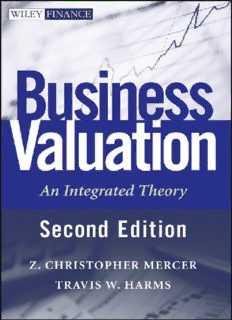
Business valuation : an integrated theory PDF
Preview Business valuation : an integrated theory
Business Valuation An Integrated Theory Second Edition Z. CHRISTOPHER MERCER, ASA, CFA TRAVIS W. HARMS, CPA/ABV, CFA John Wiley & Sons, Inc. Copyright(cid:1)c 2008byZ.ChristopherMercer.Allrightsreserved. PublishedbyJohnWiley&Sons,Inc.,Hoboken,NewJersey. PublishedsimultaneouslyinCanada. WileyBicentenniallogo:RichardJ.Pacifico. Nopartofthispublicationmaybereproduced,storedinaretrievalsystem,ortransmittedin anyformorbyanymeans,electronic,mechanical,photocopying,recording,scanning,or otherwise,exceptaspermittedunderSection107or108ofthe1976UnitedStatesCopyright Act,withouteitherthepriorwrittenpermissionofthePublisher,orauthorizationthrough paymentoftheappropriateper-copyfeetotheCopyrightClearanceCenter,Inc.,222 RosewoodDrive,Danvers,MA01923,(978)750-8400,fax(978)750-4470,orontheWeb atwww.copyright.com.RequeststothePublisherforpermissionshouldbeaddressedtothe PermissionsDepartment,JohnWiley&Sons,Inc.,111RiverStreet,Hoboken,NJ07030, (201)748-6011,fax(201)748-6008,oronlineathttp://www.wiley.com/go/permission. LimitofLiability/DisclaimerofWarranty:Whilethepublisherandauthorhaveusedtheir besteffortsinpreparingthisbook,theymakenorepresentationsorwarrantieswithrespectto theaccuracyorcompletenessofthecontentsofthisbookandspecificallydisclaimanyimplied warrantiesofmerchantabilityorfitnessforaparticularpurpose.Nowarrantymaybecreated orextendedbysalesrepresentativesorwrittensalesmaterials.Theadviceandstrategies containedhereinmaynotbesuitableforyoursituation.Youshouldconsultwitha professionalwhereappropriate.Neitherthepublishernorauthorshallbeliableforanylossof profitoranyothercommercialdamages,includingbutnotlimitedtospecial,incidental, consequential,orotherdamages. Forgeneralinformationonourotherproductsandservicesorfortechnicalsupport,please contactourCustomerCareDepartmentwithintheUnitedStatesat(800)762-2974,outside theUnitedStatesat(317)572-3993orfax(317)572-4002. Wileyalsopublishesitsbooksinavarietyofelectronicformats.Somecontentthatappearsin printmaynotbeavailableinelectronicbooks. FormoreinformationaboutWileyproducts,visitourWebsiteatwww.wiley.com. LibraryofCongressCataloging-in-PublicationData: Mercer,Z.Christopher. Businessvaluation:anintegratedtheory/Z.ChristopherMercer, TravisW.Harms,.–2nded. p.cm. Rev.ed.of:Valuingenterpriseandshareholdercashflows.Memphis: PeabodyPub.,2004. ISBN-13:978-0-470-14816-7(cloth) 1. Businessenterprises–Valuation.2. Corporations–Valuation. I. Harms,TravisW.II.Mercer,Z.Christopher.Valuingenterpriseand shareholdercashflows.III.Title. HG4028.V3M472008 658.15’5–dc22 2007008850 PrintedintheUnitedStatesofAmerica. 10 9 8 7 6 5 4 3 2 1 Contents Introduction ix CHAPTER1 DiscountedCashFlowandtheGordonModel:TheVeryBasics ofValue 1 Introduction 1 CommonQuestions 1 TheBasicToolsofValuation 2 TheDiscountedCashFlowModel 2 TheGordonModel 3 Two-StageDCFModel 4 PracticalProof:DCF=GordonModel 6 Dividends,Reinvestment,&Growth 8 IntuitiveImpactofReinvestingCashFlows 9 ReinvestmentandtheGordonModel 9 TheCoreBusinessvs.ReinvestmentDecisions 11 CoreEarningsGrowth(g )vs.Analysts’Expected e EarningsGrowth(g∗) 16 NetIncomevs.NetCashFlow 19 Multipleg’sandOnerfortheGordonModel 20 FocusAgainong —theLong-TermExpectedGrowth e RateinEarnings 21 FocusAgainong∗—theLong-TermGrowthRatein CashFlow 21 TheRelationshipbetweenNetIncomeandNetCash Flow 22 DoesrRelatetoNetIncomeortoNetCashFlow? 23 FurtherAnalysisRegardingNetIncomevs.NetCash Flow 25 PracticalObservations 28 Conclusion 32 CHAPTER2 TheGRAPESofValue 33 Introduction 33 iii iv CONTENTS CommonQuestions 33 TheWorldofValue 33 GRAPESofValue 34 ClarityComesSlowly 34 LessonsLearnedfromFirstValuationClient 35 TheOrganizingPrinciples 39 G—thePrincipleofGROWTHandTime 40 R—thePrincipleofRISKandREWARD 41 A—thePrincipleofALTERNATIVEInvestments 42 P—thePRESENTValuePrinciple 43 E—thePrincipleofEXPECTATIONS 45 S—thePrincipleofSANITY(andRationalityand Consistency) 48 TheBasketforGRAPES:ThePrincipleofKnowledge 49 ConcludingComments 49 Appendix2-A:ThePrinciplesCrystallize 51 Appendix2-B:NotSoRandomThoughtsRegardingthe BusinessofBusinessAppraisal 53 Appendix2-C:NotsoRandomThoughtsontheBusiness ofBusinessAppraisal2004Edition 56 CHAPTER3 TheIntegratedTheoryofBusinessValuation 61 Introduction 61 CommonQuestions 61 TheGordonModel 63 EarlyViewsoftheLevelsofValue 63 TheMarketableMinorityInterestLevelofValue 65 TheControlLevelsofValue 69 TheFinancialControlLevelofValue 73 FinancialControlPremium 76 PrerogativesofControl(IntroductiontotheMinority InterestDiscount) 78 TheMinorityInterestDiscount 80 StrategicControlLevelofValue 82 StrategicControlPremium 86 EnterpriseLevelsvs.theShareholderLevelofValue 87 TheNonmarketableMinorityLevelofValue 90 TheMarketabilityDiscount 93 ApplicationofMarketabilityDiscountstoControlling Interests 94 TheoreticalBasis 94 Contents v ArgumentsforControllingInterestMarketability Discounts 95 TheIntegratedTheoryofBusinessValuation 98 Conclusions 99 Appendix3-A:CaseStudy—AcquisitionPricingandthe IntegratedTheory 101 CHAPTER4 AdjustmentstoIncomeStatements:NormalizingandControl Adjustments 107 Introduction 107 CommonQuestions 108 TheIntegratedTheoryandIncomeStatementAdjustments 109 TwoTypesofIncomeStatementAdjustments 110 IncomeStatementAdjustmentsandtheRelevantDiscount Rate 111 NormalizingAdjustmentstotheIncomeStatement 112 NormalizingAdjustmentsIllustrated 114 ControlAdjustmentstotheIncomeStatement 117 PotentialValueImpactofEarningsAdjustments 120 TheNatureofControlPremiums 122 ControlPremiumsandFairMarketValue 122 ControlPremiums:ValuationResults,NotValue Drivers 124 Conclusion 125 Appendix4-A:ACautionaryTale 126 CHAPTER5 FundamentalAdjustmentstoMarketCapitalizationRates 129 Introduction 129 CommonQuestions 130 TheGrapesofValueReviewed 131 AConceptualOverviewofFundamentalAdjustments 132 RiskDifferentialsCauseFundamentalAdjustments 132 ExpectedGrowthDifferentialsCauseFundamental Adjustments 133 FundamentalAdjustmentsbyAnotherName 135 PracticalTechniquesforDevelopingFundamental Adjustments 135 QuantifyingFundamentalAdjustmentsUsingthe ACAPM 135 ComparePublicoandPrivateco 135 vi CONTENTS DetermineaFundamentalAdjustmentUsing ACAPM 137 ApplicationoftheFundamentalAdjustment 139 AdjustingEquity-BasedFundamental AdjustmentsforTotalCapitalMethods 140 UsingaFactorOtherThantheMedianorMeanto DeterminetheFundamentalAdjustment 141 ConceptualIllustrationsofFundamentalAdjustments 143 TheDouble-DippingArgument 147 MarketabilityDiscountsforControllingInterests? 147 TheLiteratureRegardingFundamentalAdjustments 150 Conclusion 151 CHAPTER6 DevelopingAppropriateDiscountRates 153 Introduction 153 CommonQuestions 154 TheAdjustedCapitalAssetPricingModel 154 DiscountRateSensitivityandJudgment 159 JudgmentandReasonablenessandtheACAPM 160 TheACAPMandShareholderLevelValuations 163 Conclusion 163 Appendix6-A:OverviewoftheCapitalAssetPricingModel (CAPM) 165 CHAPTER7 IntroductiontotheQMDM:TheShareholderLevelofValue 169 Introduction 169 CommonQuestions 169 PotentialApproachestoShareholderLevelValuation 170 TheQMDM:AShareholderLevelDCFModel 172 TheStructureoftheShareholderLevelDCFModel 173 AVisualRepresentationoftheShareholderLevelDCF Model 176 FactorsContributingtoMarketabilityDiscounts 178 BaseCase(ShareholderValueEqualtoEnterprise Value) 178 ImpactofAgencyCosts 180 ImpactofIncrementalHoldingPeriodRisks 181 CombinedImpactonOverallMarketability Discount 183 ReviewofAnalysis 183 Conclusion 183 Contents vii Appendix7-A:AFurtherLookatPre-IPOandRestricted StockStudies 185 CHAPTER8 TheQMDMAssumptionsinDetail 189 Introduction 189 CommonQuestions 189 Assumption#1:ExpectedHoldingPeriod(forthe Investment)(HP) 190 MarketabilityandtheExpectedHoldingPeriod 190 FactorstoConsiderinEstimatingtheExpected HoldingPeriod 192 HoldingPeriodAreasofInvestigation 193 EstimatingRangesfortheExpectedHoldingPeriod 195 Assumption#2A:ExpectedDividendYield(D%) 196 DeterminingExpectedDividendYields 196 AdjustingfortheTaxCharacteristicsoftheEnterprise 197 CCorporations 198 SCorporationsandOtherTaxPass-Through Entities 198 SCorporationDistributionYieldsCanBe Negative 201 ConclusionRegardingTaxEquivalentYields 202 Assumption#2B:ExpectedGrowthofDividends(G ) 202 D Assumption#2C:TimingofDividendReceipt 203 Assumption#3A:TheExpectedGrowthRateinValue(G ) 204 v FactorsInfluencingtheExpectedGrowthRateinValue 204 DevelopingG 205 v SensitivityandG 207 v Assumption#3B:AdjustmentstotheTerminalValue 209 Assumption#4:RequiredHoldingPeriod(Rateof)Return (R ) 209 hp MarketEvidenceRegardingHoldingPeriodPremiums 210 RestrictedStockDiscounts 210 TheManagementPlanningStudy 212 PubliclyTradedPartnershipReturns 214 VentureCapitalandPrivateEquityReturns 217 EstimatingtheRequiredHoldingPeriodReturn 219 TheFrameworkforEstimatingtheRequiredHolding PeriodReturns 221 MethodologyforDevelopingtheRequiredHolding PeriodReturn 222 ReviewofQMDMAssumptions 226 viii CONTENTS CHAPTER9 ApplyingtheQMDM 229 Introduction 229 ComprehensiveExampleoftheQMDMinUse 229 TheSpecificQMDMAssumptionsfortheExample 231 TheQMDMResults 234 TheConclusionIsSelectedfromWithinaRange 235 CondensedQMDMExamples 238 Example#1:AnUnleveragedFamilyLimited PartnershipHoldingLand 238 Example#2:AnUnleveragedFamilyLimited PartnershipHoldingCommercialRealEstateand ProvidingHighDistributions 240 Example#3:ALeveragedFamilyLimitedPartnership HoldingCommercialRealEstate 241 Example#4:ARapidlyGrowingCCorporationPaying NoDividends 242 Example#5:MatureCCorporationwithPotentialfor Near-TermSale 244 SummaryoftheExamples 246 TheUniformStandardsofProfessionalAppraisalPractice andtheQMDM 247 CHAPTER10 ApplicationoftheIntegratedTheorytoTaxPass-ThroughEntities 253 Introduction 253 TheNatureoftheSCorporationBenefit 254 TheEnterpriseLevelValueofSCorporations 257 OtherObservationsRegardingRelativeValueatthe EnterpriseLevel 259 TheShareholderLevelValueofSCorporations 261 SCorporationConsiderationsfortheQMDMInputs 262 ForecastPeriod 263 ProjectedInterimCashFlows 263 ProjectedTerminalValue(GrowthinValue) 264 DiscountRate 265 Synthesis 266 Conclusion 269 Index 271
Description: